3 Dollar Indian Gold Coins

 Three-Dollar Gold Pieces - the rarest pre-1933 US gold coins
Three-Dollar Gold Pieces - the rarest pre-1933 US gold coins
If any of the different pre-1933 U.S. gold coins can be labeled as rare gold coins today, it would be the 3 Dollar Indian gold coins. These unusual Three-Dollar gold pieces are identical in design to the much more commonly available Indian Head Gold Dollars. Both types of coins depict Lady Liberty as an Indian princess. According to the 1934 annual report of the US Mint, a total of only 539,792 specimens of the 3 Dollar gold piece were produced at the US Mint facilities in Philadelphia, New Orleans, San Francisco and Dahlonega between 1854 and 1889.
The 0.14512 oz Indian Princess $3 gold coin consists of 90% gold and 10% copper. Its reverse side depicts an agricultural wreath of corn, cotton, wheat and tobacco that is tied with a bow. The wreath is depicted in the same way as on the $1 piece. The coins' odd denomination of 3 Dollars was probably chosen to facilitate the trading of 3 cent postage stamps in bulk. For the same purpose, a 3 cent silver coin had been introduced in 1851. The 3 Dollar gold coin made it much easier for consumers to buy stamps in large numbers instead of individually.
When you buy gold in the form of these rare coins, you should know that two coin types exist. They distinguish themselves by the size of the lettering of the word "DOLLARS" on the reverse side. American buyers that are investing in gold for their retirement should take note that the coins are not eligible for inclusion in Individual Retirement Accounts (IRA's) since they are classified as collectible gold coins by the IRS.
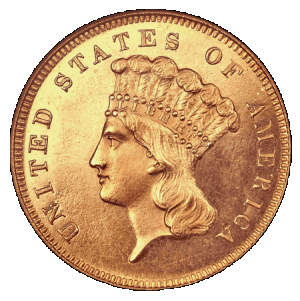
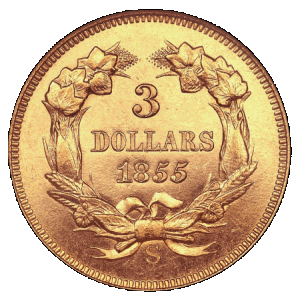
Coin Fact Sheet
| Weight | Face Value | Purity | Diameter |
|---|---|---|---|
| 0.14512 oz | US $ 3 | 90% | 20.55 mm |
Total Mintage: 539,792
Design of the $3 gold piece
The $3 gold piece is identical in design to the Indian Princess Gold Dollar. Both types of coins were designed by James B. Longacre, Chief Engraver of the Philadelphia Mint. A leftward facing Lady Liberty with a Native American headdress bearing the word "LIBERTY" is depicted on the obverse side. "UNITED STATES OF AMERICA" is engraved around the periphery of the coin.
Just like the $1 piece, the reverse side of the $3 Gold Princess coin depicts an agricultural wreath of corn, cotton, wheat and tobacco that is tied with a bow. The coin's denomination "3 DOLLARS" and the year of mintage appears at the center of the coin. Coins that were minted in New Orleans (mint mark: O), San Francisco (mint mark: S) or Dahlonega (mint mark: D) contain a mint mark just below the bow at the bottom. However, $3 Indian Princess gold coins that were minted at the main Philadelphia branch of the United States Mint don't have any mint mark.
History of the 3 Dollar gold coin
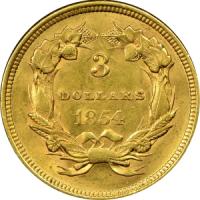
Whereas a $4 gold piece was never approved and only pattern coins were made, a gold coin with the unusual denomination of 3 dollars was authorized by a congressional bill on the 21st of February 1853. There is still some discussion among numismatists today regarding the intended purpose of this 3 Dollar gold coin. Most experts believe it was issued to facilitate the purchase of sheets of 3 cent stamps. These stamps had been authorized by Congress in 1851 along with a 3 cent silver coin. Whereas the silver coin facilitated the individual purchase of these stamps, the 3 Dollar coin made it easier to buy hundreds of 3 cent stamps at once. However, some historians believe that the California Gold Rush of that time was the true reason for the coin's introduction.
The US Mint deliberately chose to use thinner planchets for the new $3 Indian Princess gold coins than for the similarly designed $2.5 Indian Quarter Eagles, resulting in a substantially larger diameter for the new coin. Mintage started in 1854 and about 30 percent of the eventual total mintage was produced that first year alone. Due to complaints from the public, the lettering of the word "DOLLARS" on the reverse side was enlarged in 1855. The image near the top of the page shows a coin from 1855 with this enlarged lettering. Slightly above on the left, you see the reverse of a coin from 1854 with the original small lettering.
The $3 Indian Princess gold coin was never really popular among the public. However, some people used these coins as gifts or even in jewelry. During the last 10 years of mintage from 1879 to 1889, large numbers of $3 Gold Princess coins were remelted at the US Mint facility in Philadelphia. The last coins were produced in 1889 and Congress officially abolished both the 3 Dollar and 1 Dollar gold coin on the 26th of September 1890. The US Mint then still had plenty of 3 Dollar Indian gold coins in stock and 49,087 pieces (from the final years of mintage and the high mintage years 1874 and 1878) were therefore remelted in the 1890's.
Even though production of the $3 Indian Princess Head gold coin lasted from 1854 to 1889, only the US Mint facility in Philadelphia produced them every year during this period.
Rare Dates
Three-Dollar Gold Pieces from all years of mintage are nowadays extremely rare. Perhaps it is a bit easier to find coins that were minted during the first year of mintage, since 163,738 out of a total of 539,792 coins were minted in 1854 alone.
Annual proof mintage varied between 20 coins (1874, 1875, 1877, 1878) and 291 coins in 1888. Only proof coins and no regular circulation coins were minted in 1873, 1875 and 1876.
Only one 3 Dollar gold piece is known to have been minted in San Francisco in 1870.
Even though the coins are now very rare for all years of mintage, the coins minted in Dahlonega and New Orleans in 1854, San Francisco in 1855, 1857 and 1860 as well as in Philadelphia in 1873 and 1877 are nowadays especially hard to find.
Mintage Numbers
Annual mintage of 3 Dollar Indian gold coins at the various US Mint branches varied between 500 coins (Philadelphia 1881) and 138,618 coins (Philadelphia 1854). Proof coins were almost exclusively minted at the Philadelphia branch of the US Mint and proof mintage varied between 20 coins and 291 coins (1888). Actual proof mintage numbers for the years 1854 to 1858 are not quite certain.
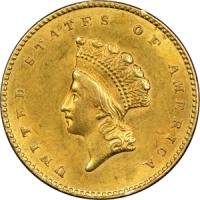
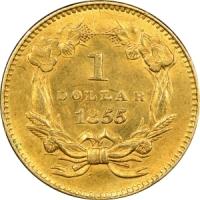
Indian Head Gold Dollars
The $1 Indian Head Gold Dollars succeeded the $1 Liberty Gold Dollars in 1854. The US Mint produced the new coins from 1854 to 1889. Two types of the coin exist that distinguish themselves by the size of the portrait on the obverse side. The coins were struck at the US Mint facilities in Philadelphia, New Orleans, San Francisco, Charlotte and Dahlonega. Their composition is 90% gold and 10% copper with each coin containing 0.04837 oz of gold. The coins' obverse shows Lady Liberty wearing a Native American headdress. Almost 7 million Indian Princess Gold Dollars were minted. An agricultural wreath of corn, cotton, wheat and tobacco that is tied with a bow can be seen on the reverse.
The Indian Gold Dollar page gives more information about the coins and allows you to compare current prices.